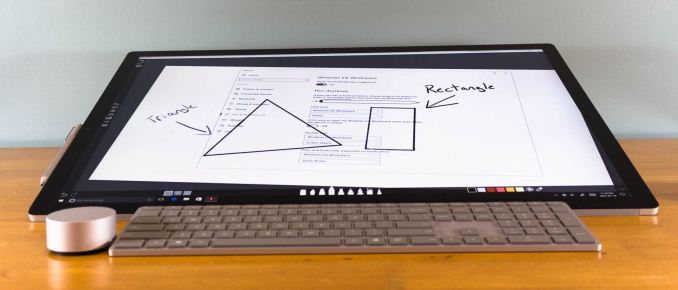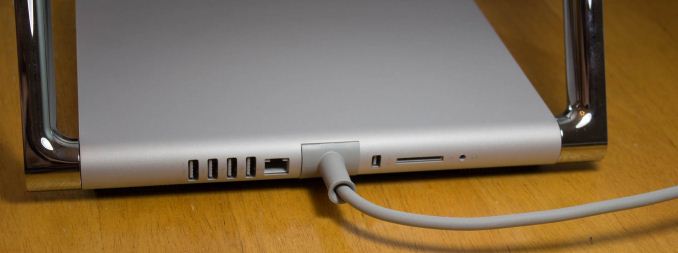The Microsoft Surface Studio Review
by Brett Howse on January 20, 2017 8:00 AM EST- Posted in
- Desktop
- Microsoft
- Surface
- Surface Studio
Design and the Zero-Gravity Hinge
Microsoft has built a brand around Surface, and that’s not an easy thing to accomplish. The Surface Studio fits in very well with the design ethos of the rest of the Surface lineup, and there has been quite a bit of attention to details paid in the creation of their first desktop computer. The first, and most obvious, is the finish, which matches perfectly with the other Surface devices, despite being made from aluminum rather than the magnesium alloy used on the portable products.
The 3:2 aspect ratio of the Surface Studio display is now a hallmark of the Surface brand (outside of Surface Hub), and having a taller display makes doing most tasks on a desktop a more pleasant experience. The increased surface area can’t be forgotten either, with the Surface Studio offering 17% more screen real estate than what's arguably the Studio's closest competitor, the 27-inch iMac, which amounts to an additional 54 square inches of display. Widescreen at 16:9 has never been a great aspect ratio for PC tasks, but the proliferation of high definition television seems to have moved the entire industry this way in an effort to save costs. When looking at the price of the Surface Studio, it’s important to remember that the entire display industry has moved to 16:9 as a standard, which impacts the entire supply chain and tooling required. Moving to an aspect ratio outside of 16:9 has large cost implications, but the end results are certainly worth it. Hopefully we will see a few other manufacturers use this as a means to source displays like this, much like the Surface Pro 3 and Pro 4 have ushered in more 3:2 devices at that much smaller size. And speaking of attention to detail, the Surface Studio is actually 28.125-inches diagonal, and as we'll see in a bit, that last 0.125-inches is very important.
It seems with Surface, Microsoft always wants to have a trick up their sleeve. With the original Surface RT and Surface Pro, it was the kickstand, which has been adopted by quite a few manufacturers for their own device since it works so well. When they launched their first laptop, the Surface Book, it was the muscle wire locking mechanism to remove the display from the base, as well as the dynamic fulcrum hinge to make the top-heavy laptop more stable. With the Surface Studio, the zero-gravity hinge is most definitely its signature design feature.
With two chrome arms flanking the base, the Surface Studio can almost effortlessly be folded down into a drafting table. The hinge mechanism provides a perfect counterbalance to the weight of the display, making it feel like it has almost no weight at all. The hinge is a single movement as well, so you don’t tip and fold the screen, but instead folding the screen also causes it to move down. While this does limit the functionality somewhat – for instance, you can't move the screen half way down and then fold it up straight again – the result is truly a wonderful design which almost needs to be seen in person.
Because you can’t tip the screen without folding it, once you stop at any angle, the screen is very solid to work with, although it is the most secure when folded all the way down to the 20° angle. You would think a large desktop display would not be ideal to use with touch, but the Surface Studio zero-gravity hinge invites you to be more interactive with it, by keeping the display close and folding it down when needed. More traditional all-in-one computers with a touch screen are nowhere near as easy to work with, since holding your arm in dead-air can be tiring, but the folded display doesn’t suffer from these burdens.
The PC base also exudes Surface quality, with the signature color, and cooling vents all the way around in the same fashion as the Surface Pro and Surface Book. The PC base can be disassembled from the bottom if required, for access to the storage and fans, but the remainder of the system is soldered to the board as you would expect in a small form factor device like this. The most frustrating part of the Surface Studio base is that all the inputs and outputs are on the rear of the device, so connecting something over USB, or inserting a SD card into the PC, is not as simple as it should be. This is a form over function decision, and it would be nice to see some of the ports offered at least on the side of the base to make it a bit easier to access.
The desktop PC market has not been as exciting to watch as the smaller and more portable laptops and tablets, but the Surface Studio sets a new high mark for desktop PC design and looks. Some of the decisions are form over function, but the majority of the design decisions actually improve the user experience. The zero-gravity hinge is a masterpiece of engineering, with such a smooth action that it really does feel like the display has no mass at all.













197 Comments
View All Comments
hoohoo - Sunday, January 29, 2017 - link
It is very nice but the price as tested is completely ridiulous.It is essentially a high spec laptop packaged in a big screen. If Asus os such were to step up it could offer the same thing for half the price.
Septillion - Wednesday, February 1, 2017 - link
So the vivid color profile aka P3 D65, is practically identical to Apple's Display P3 color profile? Same P3 primaries, D65 white point and 2.2 gamma.darwinosx - Sunday, February 5, 2017 - link
I use a Mac laptop at work and also have one at home. We have a lot of pro-Microsoft people at work including my boss who is the VP of software development. We also are working closely with Microsoft on a major project. Many of the people I work with got a Surface Pro 4 thinking they would really lie it but all of them are sick of all the issues and the service desk finally stopped allowing them because of all the issues. Several of the developers, including my boss, have Mac laptops on order now.lcf/bill - Thursday, February 9, 2017 - link
Nice to see a timely review of a product.At this point, it is looking like the Touch Bar Macbook Pro review may not be out before the hardware is revised.
IamDavid - Saturday, February 11, 2017 - link
I want to purchase the top level version but I need the ability to connect the audio to my Home Theater system. I only see a 3.5mm audio port so I assume at best I'd have stereo? Any options for have full HD audio out?macmhathain - Saturday, June 17, 2017 - link
I find this product fascinating. I'm not sure I agree that Microsoft tries to add something interesting in every computer since the Surface - they add touch to desktop PC - Suface, Surface Pro, Surface Book, Surface Laptop, and Surface studio. But, he addition of touch to a desktop PC does some very interesting things which are natural outgrowth of touch - 2 in 1 with detachable keyboard, UI that switches between desktop and tablet mode, pen support. All of these are natural outgrowths of the decision to put touch on desktops. The problem is that comes with trade-offs. The most important is cost. the Surface studio is $4000 - that would pay for an amaizngly speced out Mac or and an epically speced out traditional PC. I have heard the surface studio is slow (I don't own one but have played with it in store and based on Leo Leports comments) but what one would expect from the hardware that powers that screen (and the decision to put it into a tiny box). My wife is a professional photographer - and she really needs power in her computer. the size of her imports, running lightroom, photoshop, and a brower continually and switching between them need a powerful computer not to be slow. So the surface studio, even if it would be awesome for the occasional very precise artistic edit, wouldn't work well for the day to day grind of a photographer - and I expect the dame problem for a video editor, or graphic designer would have the same problems with lack of power. Why not attach that amazing screen to a giant box filled with i7s a ton of fast RAM and a huge SSD and a bunch of fans? sure it would cost a lot more like $10,000 - but it would do the job it is supposed to do well, unlike now where it is crippled by a trade off for aesthetics and to keep the price low (you could put at least a few better parts in the little box like a great SSD which would have helped and kept the aesthetics). I am fasciated to see who will be right. Microsoft with desktop computers need touch, or Mac that desktops needs mouse and keyboard and touch based "tablets (although a 27" ipad would be an interesting device for photo editing if it were fast enough and had enough storage)" are the only things that have touch. For me buying a computer in exchange for the additional cost for the touch screen, I'd rather have that money spent on more RAM or a better CPU or a faster SSD.Danilushka - Saturday, April 7, 2018 - link
Such a shame: Microsoft takes an innovative leap past Apple but snatched defeat from the jaws of victory sabotaged by it's buggy unreliable aged Windows operating system and poor quality control.No wonder Apple isn't rushing out large touchscreens: the competition just cannot deliver on them.
Unfortunate because competition keeps vendors innovating.